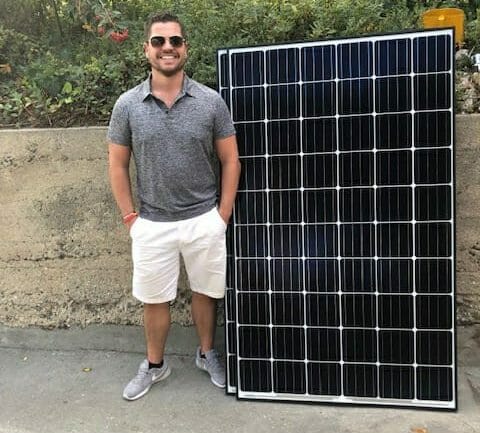Over 2,000,000 homeowners in the United States have installed solar panels. As of Q2 of 2020, the U.S. has an installed capacity of solar energy to power up to 16.1 million homes. Adding solar panels to your home is an easy decision that provides many benefits. However, it can get confusing for homeowners due to the lack of educational and accurate information out there. That’s why I decided to write this e-book. It will serve as a trusty guide to educate homeowners on the benefits and process of installing solar panels.
Over the past 5 years, I’ve consulted on hundreds of solar panel system installations on all types of roofs. Our primary area of consultation is around Southern California, but this e-book can serve as a guide for homeowners around the U.S. The sooner we implement this technology, the better off our society and planet will be for future generations. Should I go solar? Let’s find out!

The 5 Wins Of Solar Energy
I have developed our robust client base by giving talks to community groups such as Chambers of Commerce, Rotary Clubs, and real estate offices in the area to educate them on the question, “is solar a good investment?” When I explain the 5 “wins” of residential solar systems, every group has a reaction of complete shock. They realize that solar panel installation costs nothing in the long run.
-
Saves Money
To put it simply, installing solar panels saves money on your monthly electricity bills. In July 2020, the average monthly electricity rates in California were $111.41.
-
Adds Value To Your Home
California is the first state to require all new homes to have solar panels and for good reason. Residential solar panels can increase a home's value by up to 4.1% compared to homes without solar panels.
-
Creates Jobs
The job of "solar panel installer" is expected to grow by 51% from 2019 to 2029. Last year alone, the solar industry employed an additional 51,000 people.
-
Saves The Planet
If you install solar panels, you eliminate all carbon emissions from burning fossil fuels used to power your home.
-
Energy Security
Installing a battery with a solar system ensures resiliency in the event of a power grid outage.
Getting Started: The Process

System Sizing
Keep in mind that if your utility bill is low or you have a small home, then your return on investment may take longer. The first step in going solar is to engage a solar company to size your home solar system based on the previous 12 months of energy consumption data and any future improvements to the home that might affect future energy consumption.
All solar companies provide this service for free with a recent electric bill, a picture of your electrical panel, and a picture of your roof. They will answer the question, are solar panels worth it for our home.
Contracting
Site Audit
A solar system installer will come out to your home to measure and mark the roof for installation and perform a shading analysis. The site audit usually takes about one hour to complete.
Permitting
Once the layout is approved, a licensed engineer will design plans for your solar panels. The plans will be submitted to the local Authorized Housing Jurisdiction (AHJ). They will approve the plans and issue a building permit for the solar panels.
Installation
This is the actual construction and installation of solar panels on your roof. This will take from one to five days to complete.
Final Inspection
An inspector for your AHJ will come to your home to make sure that the home solar system was installed according to the proper building codes. Your installer will send a representative to accompany the AHJ inspector on this day.
Permission To Operate
Once the final inspection is passed with the AHJ, then your solar panel installer will submit the Net Metering Agreement paperwork to the utility company. The electric utility will issue a Permission To Operate (PTO) for you to start using your solar energy panels. You will start to receive energy bill credits for excess energy production.
Keep in mind that California utility companies have a backlog of Net Metering Agreements to process. It may take a couple of months before you are switched over to solar billing.
Choosing An EPC Contractor: What Does It Mean?
Engineering. Procurement. And Construction. Basically, the solar company that you hire will provide all of these services for you as a package deal.
The ‘E’ in EPC stands for engineering, which consists of a site audit and drafting of plans by a licensed engineer.
The ‘P’ in EPC stands for procurement, which is the process of procuring all the necessary materials for the project. This includes solar panels, inverters, racking, conduits, and any other materials that factor into the solar panels cost.
The ‘C’ in EPC stands for construction, which is the physical labor, building, and installation on your roof of the solar system. In your EPC sales pitch and quotes, all of the materials and labor costs will be included.
Selecting Equipment: Solar Panels
There are two primary factors when selecting solar panels to install; price and roof size. All reputable solar installation companies install Tier 1 panels. To qualify as Tier 1, a company must have supplied their own panels for 6 different projects that were financed by 6 individual banks over a 2-year period.
Roof Size. If you have a large roof with a lot of space, then you are probably okay to install solar panels that have a lower wattage of about 300 watts. If you have a smaller roof, then you may need to install premium panels that are typically around 360 watts.
Price. Premium panels are more expensive than standard ones. While they both carry the same warranty of 25 years, they differ in cost due to their wattage and efficiency. The difference in cost is generally around 10-25% more for premium panels.
Selecting Equipment: Solar Inverters
The two main players that make solar power inverters are Enphase and Solaredge. They both perform the same function of converting direct current to alternating current. Enphase makes microinverters, while Solaredge makes central inverters with DC optimizers.
Central Inverter. This option is the cheapest and consists of a single inverter to connect your entire array of solar cells. The downside of these is that if one panel stops working, then the whole solar array can malfunction.
Microinverters. This option requires that a small inverter be installed on each panel, which will maximize the power production. These inverters help minimize performance issues if a panel becomes shaded or malfunctions.
Power Inverters. This option is also installed at each panel and is a combo of the previous two inverter types. It helps limit the overall system downtime if one-panel malfunctions.
Should You Install A Solar Battery?
While a grid-tied solar system is the most popular option, many homeowners are opting to install solar batteries that will save and store solar energy. Even if the grid goes down, you will still have electricity. To accomplish this, a solar panel array is paired with an energy storage system (ESS).
How Do Solar Batteries Work?
An ESS system stores excess solar power from your panels instead of sending it back to the grid. The battery system can be used when your solar panels are not producing as much electricity such as when it’s raining or at night. You will only send electricity back to the grid once the battery is fully charged.

Lease vs. Buy
We recommend buying outright or financing your solar panel system. It will give you the most return on your solar investment in the long term.
Lease. With this option, a homeowner will sign a contract to lease the solar equipment from the solar company. The solar company provides the monthly lease at a lower rate than their current cost of electricity. The monthly payment typically increases by 2.9% each year for a period of 20 years. The homeowner does not technically own the solar power system, so they don’t receive a tax credit.
Financed Purchase. This option allows homeowners to take out a loan for 10, 12, 15, or 20 years. These loans usually don’t require any down payment or upfront cost. The lender uses a “split loan” structure where you make payments on 78% and 22% is meant to be paid off by the federal tax credit at the end of the loan. With this option, you start seeing savings right away.
Cash. Homeowners buy the solar panels outright. Most install companies require a $1000 down payment, 80% payment before installation, and 20% after completion.
Tax Credits
Is solar energy cost-effective? Well, these tax credits sure help! The federal tax credit is available to all homeowners that install a solar system up through 12/31/21. The current Federal tax credit is set at 22% for projects installed by 12/31/21. For example, if your solar array costs $30,000, then you would receive $6,600 as a Federal Tax credit. There might also be local incentives.
Other Incentives: Net Energy Metering
Net Energy Metering (NEM) is the financial incentive that utility companies offer people for going solar. Basically, this incentive allows you to store energy on the grid, which can then be used as bill credits on your electricity bill. It is useful when you may be entering a rainy season.
How Does Net Metering Work?
Net metering acts as a savings plan that protects against fluctuating electricity rates and solar panel underproduction. NEM helps account for daily variations in our electricity usage. Excess electricity is fed into the electric grid during high levels of solar energy production. When this happens, your electric meter runs in reverse, which helps you save money on your utility costs.
Solar Monitoring
Solar monitoring allows you to keep track of your solar energy production system in real-time. Both Enphase and Solaredge offer tracking apps that allow you to monitor your system from a mobile phone or desktop. You can see how much energy you are producing and storing if you have a solar battery. We recommend checking your system at least once a week to ensure that it’s working properly.
Final Word: Price Per Watt
So, is solar power cost-effective? Now, it’s time for the true industry secrets that most homeowners don’t know. The solar industry uses a price per watt (PPW) system for calculating the cost of solar projects. The whole project, including profit, is based on the energy system’s size and a set PPW. It doesn’t matter how much labor is needed, how many panels you need, or the manufacturer. All other variables are wrapped into this one figure.
For example, a 10 KW system costs about $3.25 per watt in California. The average installation cost is about $32,500 in the state. If any additional work needs to be done, like a new electric panel or main panel upgrade, most solar companies will do these at cost. For example, a new electric panel costs about $2,000 for the solar company. They will pass that cost onto the customer. Many solar companies will try to add excess cost for additional upgrades, so beware of these shady sales tactics. So, is the cost of solar panels worth it in 2020?

Conclusion
If you take nothing else away from this guide, the one question you need to ask your EPC contractor is… what is your price per watt for installing my solar panels? This question could save you thousands on your home system when you go solar. When you are shopping around for solar quotes, ensure that you are asking for the same equipment from each EPC so that you get a fair comparison price. For example, if you have microinverters in one quote, then make sure you have them in each quote.
I hope this ebook has helped you with your solar education and clarified the process of going solar. You should now have enough information to dictate terms with your solar installer instead of the other way around.
If you’re still asking yourself if you could benefit from solar panels, reach out to us for an all in one, turnkey solution. But before booking a call, we’d first like to get to know your needs! Please email us your utility bill as well as the picture of your roof and electrical panels, and we will get back to you ASAP. During our call, we can discuss all the details, including engineering, procurement, and contracting for the entire process.






